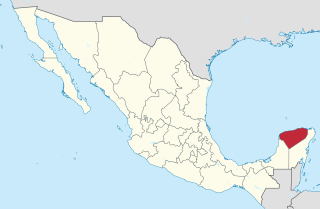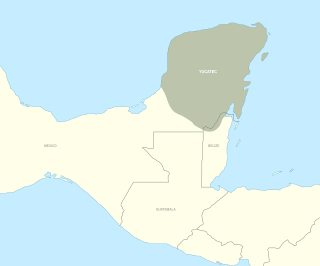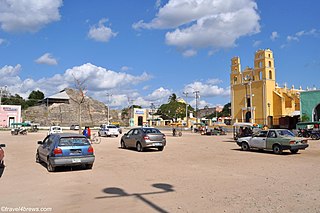See also
| This disambiguation page lists articles associated with the title Itza. If an internal link led you here, you may wish to change the link to point directly to the intended article. |
Itza may refer to:
| This disambiguation page lists articles associated with the title Itza. If an internal link led you here, you may wish to change the link to point directly to the intended article. |

Yucatán, officially the Free and Sovereign State of Yucatán, is one of the 32 states which comprise the Federal Entities of Mexico. It is divided into 106 municipalities, and its capital city is Mérida.
Maya may refer to:
Mayan most commonly refers to:

The Maya peoples are an ethnolinguistic group of indigenous peoples of Mesoamerica. The ancient Maya civilization was formed by members of this group, and today's Maya are generally descended from people who lived within that historical civilization. Today they inhabit southern Mexico, Guatemala, Belize, El Salvador and Honduras. "Maya" is a modern collective term for the peoples of the region, however, the term was not historically used by the indigenous populations themselves since there never was a common sense of identity or political unity among the distinct populations, societies and ethnic groups because they each had their own particular traditions, cultures and historical identity.

Yucatec Maya, is a Mayan language spoken in the Yucatán Peninsula and northern Belize. Native speakers do not qualify it as Yucatec, calling it literally "flat/Maya speech" in their language and simply (el) maya when speaking Spanish.

The Itza are a Guatemalan people of Maya affiliation. They inhabit the Petén department of Guatemala in and around the city of Flores on Lake Petén Itzá.
Itzaʼ is a critically endangered Mayan language spoken by the Itza people near Lake Peten Itza in north-central Guatemala. The language has only about 1,000 speakers, all older adults.
Mopan is a language that belongs to the Yucatecan branch of the Mayan languages. It is spoken by the Mopan people who live in the Petén Department of Guatemala and in the Maya Mountains region of Belize. There are between three and four thousand Mopan speakers in Guatemala and six to eight thousand in Belize.

Tombs & Treasure, known in Japan as Asteka II: Templo del Sol, is an adventure game originally developed by Nihon Falcom in 1986 for the PC-8801, PC-9801, FM-7, MSX 2 and X1 Japanese computer systems. An Famicom/NES version, released in 1988, was altered to be more story-based, and featured new music and role-playing elements; an English-language NES version was published by Infocom in 1991. Japanese enhanced remakes were released for the Saturn and Windows systems in 1998 and 1999, respectively.

Maya architecture spans several thousands of years, several eras of political change, and architectural innovation before the Spanish colonization of the Americas. Often, the buildings most dramatic and easily recognizable as creations of the Maya peoples, are the step pyramids of the Terminal Preclassic Maya period and beyond. Based in general Mesoamerican architectural traditions, the Maya utilized geometric proportions and intricate carving to build everything from simple houses to ornate temples. This article focuses on the more well-known pre-classic and classic examples of Maya architecture. The temples like the ones at Palenque, Tikal, and Uxmal represent a zenith of Maya art and architecture. Through the observation of numerous elements and stylistic distinctions, remnants of Maya architecture have become an important key to understanding their religious beliefs and culture as a whole.

Acanceh is a town and ancient Maya archaeological site located in Mexico's Yucatán State, 21 kilometers from Mérida, the capital of Yucatán. It is the seat of Acanceh Municipality. The modern town of Acanceh, is partially atop the pre-Columbian site, and occupation seems to have been continuous. Acanceh means "groan of the deer" in the Yucatec Maya language.
Castillo may refer to:

The Kowoj [koʔwox] was a Maya group and polity, from the Late Postclassic period of Mesoamerican chronology. The Kowoj claimed to have migrated from Mayapan sometime after the city's collapse in 1441 AD. Indigenous documents also describe Kowoj in Mayapan and linguistic data indicate migrations between the Yucatán Peninsula and the Petén region.
Jungle tourism is a subcategory of adventure travel defined by active multifaceted physical means of travel in the jungle regions of the earth. Although similar in many respects to adventure travel, jungle tourism pertains specifically to the context of region, culture and activity. According to the Glossary of Tourism Terms, jungle tours have become a major component of green tourism in tropical destinations and are a relatively recent phenomenon of Western international tourism.
Sentinels of Silence is a 1971 short documentary film on ancient Mexican civilizations. The film was produced by Manuel Arango, and directed and written by the filmmaker Robert Amram, and is notable for being the first and only short film to win two Academy Awards.
The Mopan people are an indigenous, sub-ethnic group of the Maya peoples. They are native to regions of Belize and Guatemala.

Chichen Itza was a large pre-Columbian city built by the Maya people of the Terminal Classic period. The archaeological site is located in Tinúm Municipality, Yucatán State, Mexico.

El Caracol, the Observatory, is a unique structure at pre-Columbian Maya civilization site of Chichen Itza. El Caracol, which means 'snail' in Spanish, is so named due to the spiral staircase inside the tower.

The Yucatecan languages are a branch of the Mayan family of Mexico, Belize, and Guatemala.
Caracol, or El Caracol, from the Spanish term for "spiral shaped", may refer to: